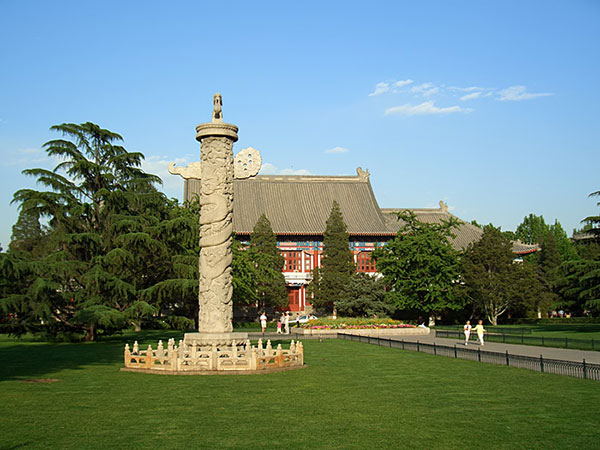
Kyoto Review for Southeast Asia Issue 10 (August 2008): Southeast Asian Studies in China
Due to their geographical location, China and the ASEAN countries have long maintained close ties, especially since 1991, when the two sides established a dialogue relationship. In November 2002, the leaders of China and the ASEAN counties signed the Framework Agreement on Comprehensive Economic Cooperation between China and ASEAN in Phnom Penh, the capital of Cambodia. Since then, communications and cooperation in politics, economics, diplomacy, and culture have grown rapidly. After three successful China-ASEAN Expositions held in Nanning, Guangxi Zhuang Autonomous Region, between November 2004 and October 2006, economic and trade relations and international multilateral cooperation between China and ASEAN have entered a new era of development. In this era, Southeast Asian languages have increasingly functioned as a very important bridge for communication. Therefore, language departments in colleges and universities in China that teach Southeast Asian languages are gradually becoming the focus of common concern, facing great opportunities for development as well as new challenges.
The Current Situation of Departments of Southeast Asian Languages in China
With close contact on the rise, language learning has become very popular in both China and the ASEAN countries. Many of the latter are sending their undergraduate students to China to study Chinese. A lot of universities in Guangxi Zhuang Autonomous Region and Yunnan province in western China have established long-term education cooperation with universities in ASEAN countries. Chinese now stands as a most popular language in Southeast Asia.
Since the process for setting up the China-ASEAN Free Trade Area began, there has been a corresponding rush to learn Southeast Asian languages in China. Currently, nine universities in China offer undergraduate programs in the languages of Southeast Asia. Among them are, in the north, Peking University, Beijing Foreign Studies University, and Communication University of China, and in the south, Guangxi University for Nationalities, Yunnan Nationalities University, Guangdong University of Foreign Studies, and Shanghai International Studies University. Table 1 shows the distribution of the programs.
Table 1. Distribution of Southeast Asian Language Programs (excluding Guangxi)
|
Programs of Southeast Asian Languages |
Distribution in China’s Universities |
Remarks |
|
Undergraduate 4-year regular program in Thai Language and Culture |
Guangdong University of Foreign Studies |
Guangdong University of Foreign Studies set up the program (major) in 1970 with a schooling system of five-year. In 2004, the system was changed to four years. |
|
Undergraduate 4-year regular program in Vietnamese Language and Culture |
Guangdong University of Foreign Studies |
Peking University set up the program (major) in 1949, followed by University of International Business and Economics in 1954, Guangdong University of Foreign Studies in 1970, Communication University of China in 2002. |
|
Undergraduate 4-year regular program in Burmese Language and Culture |
Peking University |
|
|
Undergraduate 4-year regular program in Indonesian Language and Culture |
Guangdong University of Foreign Studies |
Guangdong University of Foreign Studies set up the Program (major) in 1970 with five-year schooling system. In 2004, the system was changed to four years. |
|
Undergraduate 4-year regular program in Filipino Language and Culture |
Peking University |
|
|
Undergraduate 4-year regular program in Lao Language and Culture |
Yunnan Nationalities University |
Beijing Foreign Studies University set up the program (major) in 1961. |
|
Undergraduate 4-year regular program in Cambodian Language and Culture |
Beijing Foreign Studies University |
Beijing Foreign Studies University set up the program (major) in 1961. |
|
Undergraduate 4-year regular program in Malaysian Language and Culture |
Communication University of China |
Peking University was the first to set up a program in a Southeast Asian language and literature – as early as the year of the founding of the People’s Republic of China. Currently, Beijing Foreign Studies University and Luoyang Foreign Language Institute offer the largest number of Southeast Asian language programs, each teaching seven languages.
Since the establishment of these language programs, the universities involved have turned out for China a large number of well-qualified specialists who have used their learning in fields such as diplomacy, economy and trade, military, customs, Party and government administration, overseas broadcasting, tourism, and institutions of higher education. They have made great contributions to China’s foreign relations and economic and social development, and have played a vital role in promoting mutual understanding, communication, and cooperation between China and ASEAN countries.

The Current Upsurge of Southeast Asian Language Learning in Guangxi
Nanning, the capital city of Guangxi Zhuang Autonomous Region, is blessed with the geographic advantage of proximity to ASEAN. Since it was awarded the hosting of the annual China-ASEAN Expo, Southeast Asian languages have become increasingly popular in Guangxi. Therefore, the demand for language professionals by various industries and sectors has also been on the rise. In order to adapt to economic and social development, the Southeast Asian language departments of colleges and universities in Guangxi have not only expanded the number of enrollments, but also set up new programs (majors) to teach the languages and literature of more Southeast Asian countries. Table 2 gives a general picture of their distribution.
Table 2. Distribution of Southeast Asian Language Programs in Guangxi
|
Institution |
Vietnamese |
Thai |
Burmese |
Indonesian |
Lao |
Cambodian |
|
Guangxi University for Nationalities1 |
Under- |
Under- |
Under- |
Under- |
Under- |
Under- |
|
1 Vietnamese and Thai programs (majors) were set up in 1964, the Lao program in the 1960s, the Cambodian program in 2000, and Burmese and Indonesian programs (majors) in 2005. |
||||||
|
Guangxi University of Finance and Economics2 |
3-year program Southeast Asia trade major and a second foreign language (optional) |
A second foreign language (optional) |
|
|
|
|
|
2 Thai is currently only an optional course for students. |
||||||
|
Guangxi International Business Vocational College3 |
3-year program business Vietnamese major |
3-year program Thai major |
|
|
|
|
|
3 The schooling for both programs is 3 years. The Thai major began its enrollment in 2006 and now enrolls 49 students in one class. In 2007 it may expand enrollment depending on the demand. |
||||||
|
Guangxi Agricultural Vocational College |
3-year program of applied Vietnamese major |
|
|
|
|
|
|
Guangxi Jiaotong Vocational College |
Higher vocational education program of Vietnamese |
|
|
|
|
|
|
Guangxi Industrial College |
Business Vietnamese |
|
|
|
|
|
|
Guangxi Huaqiao College4 |
Technical secondary education program of business Vietnamese |
Technical secondary education program of business Thai |
|
|
|
|
|
4 The programs have been running for several years, each having 50-60 students in 6 classes, totaling 300-360 students. |
||||||
|
Guangxi Dongfang Foreign Language College5 |
Higher vocational education program of applied Vietnamese |
Higher vocational education program of applied Thai |
|
|
|
|
|
5 The Thai program began its enrollment in 2006. There are now 6 classes, of 40-50 students each. There is one Cambodian class of 29 students. |
||||||
|
Guangxi Education College6 |
Higher vocational education program of Vietnamese and short training course for basic Vietnamese |
|
|
|
|
|
|
6 Majors of Tourism Management also study Vietnamese. |
||||||
|
Provincial Youth League College of Guangxi |
Technical secondary education program of business Vietnamese |
|
|
|
|
|
|
Guangxi Nanning Teachers College |
Higher vocational education program of applied Vietnamese |
|
|
|
|
|
|
Nanning Vocational College7 |
Applied Vietnamese |
Applied Thai |
|
|
|
|
|
7 The programs started 2 years ago. Now each grade has 2 Thai classes (of about 40 students each) and 2 Vietnamese classes (of 40-50 students each). |
||||||
|
Longzhou Teachers College8 |
Applied Vietnamese |
Applied Thai |
|
|
|
|
|
8 Vietnamese program started 2 years ago. Now each grade has 3 classes and each Class 30-40 students. Thai program was set up just last year, having 2 classes now, each with 30 students. |
||||||
Clearly, after the launch of the process leading to the China-ASEAN Free Trade Area, some regular 4-year undergraduate universities, junior colleges, and technical secondary schools have offered or added many programs or majors focusing on Southeast Asian languages, business, and tourism. For example, in addition to its well-established majors in Vietnamese, Lao, Thai, and Cambodian, Guangxi University for Nationalities added majors in Burmese and Indonesian with the approval of the Ministry of Education in 2005. Guangxi University of Finance and Economics launched a Vietnamese program in its Southeast Asia business department. Many junior colleges and technical secondary schools have set up new Southeast Asian language programs as well.
Some Urgent Problems behind the Rush for Southeast Asian Languages
Currently the majority of Southeast Asian language programs operated by universities, junior colleges, and technical secondary schools are exhibiting many problems.
First, in just a few years, it seems, the number of people studying Southeast Asian languages has skyrocketed. In addition to the Southeast Asian language majors in nine universities, some students in colleges and technical secondary schools are learning them, and a few training schools also offer short-term courses. However, the actual number of people who are dedicated to learning these languages is hard to determine exactly, and it is definitely not as high as internet data indicate. And although a great number of people are studying the languages of Southeast Asia, only a few become competent in using them.
Most of the students do not gain a good command of the language they are studying, especially those in junior colleges and technical secondary schools which lack competent teachers and necessary facilities. Furthermore, some students just blindly follow the crowd to study the languages of Southeast Asia, not out of their own interest but because there are in “vogue.” Such motivation and environment are certainly not conducive to their study.
What is more, driven by market profits, some junior colleges and technical secondary schools have set up language programs and started recruiting students even though they are not equipped with sufficient teachers and teaching resources. As far as the author knows, at present, in the majority of junior colleges and technical secondary schools, the number of students in a class amounts to forty to fifty, sometimes even sixty. Such a size is obviously unfavorable to study and definitely limits students’ potential for learning a language. We see an irresolvable contradiction between the relatively few teachers, inadequate teaching facilities, and teaching resources and the relatively large number of students. This undoubtedly affects the teaching quality and the improvement in student quality and ability in those schools.
As we all know, learning language requires repeated practice and face-to-face pronunciation correction. Each and every student should get as many opportunities as possible to practice the spoken language. Therefore, according to the general norm of education management, the number of students in a language class should be less than twenty to ensure that every student has change to practice in every class. Only in this way can students be trained to become qualified language professionals.
Second, Southeast Asian language programs in nine Chinese universities more or less focus their effects on developing undergraduate programs rather than on high-level master’s and doctoral education. Currently, of the nine universities, only Peking University has been authorized to run a doctoral program and post-doctoral research center in Asian and African languages. Excluding the military academy, only three universities – Beijing Foreign Studies University, Guangxi University for Nationalities, and Yunnan Nationalities University – are competent to operate an MA program in Asian and African languages and literature. The others focus only on undergraduate programs. Obviously there is a sharp contrast: the number of undergraduates is too large while that of graduate students is too small. At Guangxi University, for example, the ratio of undergraduate to graduate students of Vietnamese is about 17.5:1; the ratio of undergraduate to graduate students of Thai is about 37.8:1. The ratios in the other two universities are almost the same.
Moreover, in these nine Chinese universities, the development of Southeast Asian language programs is unbalanced in terms of language variety. None of them cover all the languages of Southeast Asia. Almost all have established programs for Vietnamese and Thai, but Lao, Indonesian, Burmese, Malay, and Cambodian are not common. Pilipino is scarcely offered, except at Peking University.
In a word, Southeast Asian language programs are time-honored in China. And recent years have witnessed the flourishing of these programs in Chinese universities and colleges. However, breakneck development has led to the abovementioned imbalance. It is an irrational development trend to have far too many language majors at junior colleges and high vocational colleges compared with a relatively small number of language majors trained to be high-level professionals.
Development Trends in Southeast Asian Language Programs
First, economic and social development and closer cooperation in the process of building up the China-ASEAN Free Trade Area will continue to generate great demand for high-level professionals and all-around talent. In light of this, the Southeast Asia language programs will develop a more rational model for training language specialists. Chinese universities will expand the scale of their MA and doctoral programs on the languages of Southeast Asia step by step.
Second, with rapid social development, the curricula or different language programs will make the proper adjustments, adding new courses to be more relevant and comprehensive. Currently, the main courses in the majority of language programs are phonetics, spoken language, listening and speaking, a basic course for language learning, advanced courses for language learning, translation theory and practice (interpreting and translation), selected readings in literature, and literary history. To cater to the needs of economic and social development, courses such as society and culture, national customs and culture, history and relations between China and the relevant country, law, finance and trade, the language of tourism, and computer word processing in the target languages will be added, turning the traditional language skill training program into an integrated and comprehensive course.
Third, trilingual or multilingual professionals who know one to two languages of Southeast Asia in addition to English are urgently sought in today’s society. With the accelerated process of economic globalization, professionals who know only one foreign language can hardly meet the need of market. Those who have a good command of English and of more than one Southeast Asian languages will be the most competitive.

[quote]Most of the students do not gain a good command of the language they are studying, especially those in institutions which lack competent teachers and necessary facilities.[/quote]
In order to improve students’ professional skills and foster talent who are tri- and multilingual, the training of teachers will become a top priority. Universities will attach greater importance to the professional training of young and middle-aged teachers via multiple channels. The strategies of “sending out” and “inviting in” should be adopted. “Sending out” means that young and middle-aged teachers are encouraged to pursue a master’s and doctoral degree, studying in the target country as students or visiting scholars. “Inviting in” means that foreign specialists and scholars are invited to give lectures and renowned domestic scholars are invited to offer their suggestions and guidance. In so doing, the education background of the young and middle-aged teachers will be more rational, the structure of their knowledge will be improved, and their teaching and research capacities will be enhanced.
Finally, the Southeast Asian language programs at junior colleges and technical secondary schools need to meet three tests or they will sooner or later be eliminated: improve the overall quality of their graduates to meet the needs of society, reform their existing model of teaching and management, and improve the training of teaching staff and funding of teaching facilities.
The author predicts that in the near future, there will be too many people with basic or intermediate knowledge of Southeast Asian languages and too few high-level specialists with a good command of languages and comprehensive abilities. Language programs in universities will make their curricula more rational and relevant and train their young and middle-aged teachers via various channels to improve their professional skills. Students will be trained to master more than two languages in a more integrated and comprehensive way.
Some Suggestions
First, it is hoped that the appropriate authorities regulate and give proper guidance regarding the current unreasonable setup of Southeast Asian language programs and keep the number of their enrollments at a manageable level. This is necessary in order to curtail the wild growth in the number of programs as well as students.
Second, universities should promote exchanges and communication in academic fields and in research on teaching methodology with a view to improving, via various channels, the competence and structure of knowledge of language teachers. All kinds of optional courses should be offered to students and lively extracurricular activities organized to create a more favorable academic atmosphere and more encouragement for their studies.
Third, on the basis of the current MA programs, universities should redouble their efforts to prepare to launch more advanced doctoral programs on the languages and culture of Southeast Asia, which would in turn improve their existing BA and MA programs.
Fourth, universities should redesign the curricula of language programs, avoiding concentration on language skills training only. They should offer courses more closely related to social development and catering to social needs, such as society and culture, history, law, international politics, finance, national customs, tourism management, and so on.
Finally, in addition to their major language studies, students of Southeast Asian language programs should try their best to have a good command of English, endeavoring to be the all-around trilingual or multilingual professional urgently needed by society.
Chen Hui
College of Ethnology & Sociology, Guangxi University for Nationalities
This article was first published in Around Southeast Asia 2007, no. 3, and was translated for KRSEA by Hu Jing.
Kyoto Review of Southeast Asia Issue 10 (August 2008): Southeast Asian Studies in China
Bibliography
Qi Huan and Du Tao. 2004. “Review of the Political and Economic Relationship between the China and the ASEAN Countries in 2003.” Journal of Yunnan Finance & Economics University19(3).
Huai Yu. 2004. “A Strategic Thought on the Globalization of Higher Education Between Yunnan and ASEAN.” Around Southeast Asia 8.
Fang Wei and Tang Yongjun. 2003. “Consideration of Internationalization Strategy of Guangxi-ASEAN Higher Education.” Around Southeast Asia 11.
Zhang Xiaoqin. 2005. “Give Full Play to Existing Advantages and Uniqueness and Build Up Famous Brand for Non Universal Foreign Languages Programs.” Higher Education Forum 1.

